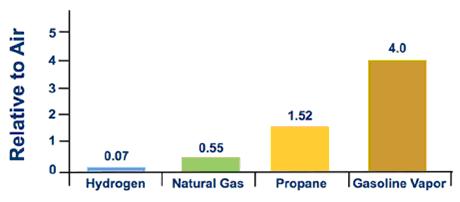GASEOUS HYDROGEN PROPERTIES AND BEHAVIORS
Some basic properties and behaviors of gaseous hydrogen are highlighted on this page. For more information on hydrogen properties, see Hydrogen Compared with Other Fuels.
- Hydrogen is a gas at ambient conditions.
- It is the lightest molecule in the universe.
- It is 14 times lighter than air, so it rises at almost 20 meters per second (44 miles per hour) and disperses rapidly. This buoyancy is a built-in safety advantage in an outside environment.
- It is colorless, odorless, tasteless, and undetectable by human senses.
- It is non-toxic and non-poisonous; however, it can be an asphyxiant.
- It is flammable and explosive over a wide range of concentrations, so it should be safely stored and used in an area that is free of heat, flames, and sparks.
- It is non-corrosive, but it can embrittle some metals (i.e., cause significant deterioration of the metal's mechanical properties).
Photo: Figure 1 - Relative Vapor Density


